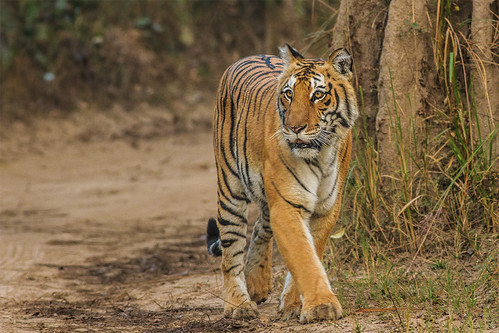根據印度政府21日公布的報告,印度野生虎數量增加至4年前的30.5%,達2,226隻。世界自然基金會(WWF)表示,這次的調查結果顯示,即使是在人口密集、經濟快速發展的亞洲,仍可能達成積極的物種復育目標。
保育曙光 印度虎破2千隻
印度國家老虎保育局發表「2014年印度虎狀態報告」(Status of Tigers in India,2014)指出,經歷數十年盜獵和棲地破壞的印度虎,總算出現保育曙光。
2006年官方估計印度只有1,411隻野生虎,略少於全球野生虎數量的一半。2010年估計增加到1,706隻。
根據報告,要維繫印度虎的存續,必須讓繁殖中的虎群能有不受打擾的核心棲地、棲地相連並遏止盜獵老虎和其獵物。
保育措施一連串 盜獵仍是首要威脅
印度環境森林暨氣候變遷部長Prakash Javadekar說,政府改善老虎保育措施,搭配有效森林管理和社群參與,讓野生虎數量增加。
他將野生虎數量增加歸功於一連串的政府作為,包括特種老虎保護部隊、特殊幼虎計畫以及控制盜獵和人獸衝突的措施。Javadekar說,印度願意捐贈幼虎給國際社群,並在全球老虎保育上扮演重要角色。
最新野生虎數量統計報告,針對18個印度已知有野生虎棲息的省份、總計378,118平方公里的森林進行調查。調查員捕捉到1,540隻不同老虎的影像。結果顯示有4個省份的野生虎數量增加。
與老虎數量統計一起進行,什瓦利克恒河平原老虎棲地森林覆蓋調查也發現,老虎棲地核心地區的森林覆蓋亦有所改善。
不過盜獵仍然是野生虎的最大威脅,今日虎製品在全亞洲的需求仍高。
「Tx2」12年期野生虎復育計畫
2010年起,所有有野生虎的國家串連合作,訂定「Tx2」目標,欲將野生虎數量從3,200隻增加一倍。Tx2是一個12年期計畫,從上一個虎年2010年開始,至下一個虎年2022年。
Tx2計畫的核心是讓各國統計自家境內的野生虎數量。印度2014年的統計是規模最大也最徹底的一次野生虎數量普查。
WWF是2010年老虎高峰會的幕後推手,也透過政治力量驅動,推展Tx2計畫,確保老虎復育仍是各國政治領袖的重要課題,同時也透過訓練巡守員、訂定保育標準和開發保育科技,以達到零盜獵的目標。
India’s wild tiger population has risen to 2,226 animals, an increase of 30.5 percent since the last estimate four years ago, according to a new report published today by the government of India.
The report, “Status of Tigers in India, 2014,” issued by the National Tiger Conservation Authority, is welcome good news about tiger recovery after decades of poaching and habitat destruction. It shows that the future of tigers in India depends on maintaining undisturbed core habitats for breeding tiger populations, habitat connectivity and protection from poaching of tigers and their prey.
In 2006 the government estimated there were just 1,411 wild tigers in India, a little less than half of all the world’s tigers remaining in the wild. By the 2010 estimate, India’s tiger population had increased to 1,706 animals.
Prakash Javadekar, minister for environment, forests and climate change said that government initiatives to streamline tiger conservation along with effective forest management and community participation had led to the increasing tiger population.
He attributes the rising tiger population to the success of various government measures – the Special Tiger Protection Force, Special Programme for Orphan Tiger cubs, efforts to control poaching and initiatives to minimize human-animal conflict and encroachment.
India is willing to donate tiger cubs to the international community and play a key role in global tiger conservation efforts, the minister said.
The new tiger population estimate is based on a survey of 378,118 square kilometers of forest area in 18 Indian states known to be inhabited by tigers. Investigators captured a total of 1,540 unique tiger photos.
The survey shows that tiger populations have increased in the states of Karnataka, Uttarakhand, Madhya Pradesh, Tamil Nadu, and Kerala.
The accompanying assessment of the change in forest cover in the tiger landscape of the Shivalik-Gangetic Plain indicates an improvement of forest cover in core areas of tiger reserves.
“To undertake a census at this scale reflects the dedication, experience and leadership of the Indian National Tiger Conservation Authority,” said Mike Baltzer, leader of WWF’s Tigers Alive Initiative. “However this investment and hard work can so easily be undone by poachers and it is imperative all tiger governments step up efforts to achieve zero poaching.”
Poaching remains the greatest threat to wild tigers today with tiger parts in high demand throughout Asia.
Since 2010, all tiger range countries have been working to double global tiger numbers from an estimated 3,200 animals, a goal known as Tx2.
TX2 is a 12-year global goal, from the last Year of the Tiger on the Chinese calendar in 2010 to the next in the year 2022.
An essential part of Tx2 is for countries to count their tigers. India’s 2014 tiger estimation is the largest and most thorough tiger census ever undertaken.
This encouraging tiger population estimate from India, coupled with the increase from the last census, demonstrates that even in densely populated and economically booming Asia, ambitious targets for species recovery can be achieved, said WWF in a statement today.
WWF was a driving force behind the Tiger Summit in 2010 and remains a major force behind TX2 by driving political momentum to ensure tigers remain a top priority for world leaders, professionalizing wildlife protection by training rangers, as well as developing conservation standards and technology to achieve zero poaching.
※ 全文及圖片詳見:ENS







